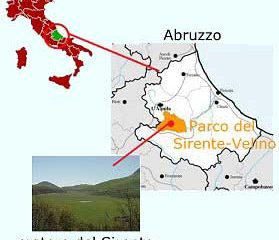Earth Sciences
Earth Sciences (also referred to as Geosciences), which deals with basic issues surrounding our planet, plays a vital role in the area of energy and raw materials supply.
Earth Sciences comprises subjects such as geology, geography, geological informatics, paleontology, mineralogy, petrography, crystallography, geophysics, geodesy, glaciology, cartography, photogrammetry, meteorology and seismology, early-warning systems, earthquake research and polar research.

The Sirente crater field: The first impact crater in Italy
In the Prati del Sirente plain in the heart of the Abruzzo mountains, a small circular lake is clearly visible. A prominent ridge encircles the lake. The peculiar appearance of the lake drew the attention of this papers first author (Jens Ormö) when working in Pescara between 1999 and 2002. Jens did at that time a European Union Marie Curie post-doc as an impact geologist at the International Research School of Planetary Sciences (IRSPS), Universita d’Annunzio. After the years of research that follo

The arctic perennial sea ice could be gone by end of the century
A NASA study finds that perennial sea ice in the Arctic is melting faster than previously thought–at a rate of 9 percent per decade. If these melting rates continue for a few more decades, the perennial sea ice will likely disappear entirely within this century, due to rising temperatures and interactions between ice, ocean and the atmosphere that accelerate the melting process.
Perennial sea ice floats in the polar oceans and remains at the end of the summer, when the ice cover is at its

Collapse Area Can Be Predetermined
Collapse in the mines can be foreseen in advance and the caving-in location and time can be identified. This has become possible due to the basic research carried out by scientists of the Ioffe Physical & Engineering Institute, Russian Academy of Sciences. Specialists of INTERUNIS company have undertaken to embody the above concepts in a prototype model of the device.
The system will consist of the ’’case on wheels’’ containing the computer and signal processing cards, and several sensors (

Natural radioactivity used to determine seasonal changes in groundwater supply
The discharge of groundwater to coastal waters represents an important source of dissolved nutrients and contaminants that may affect chemical and biological processes in coastal ecosystems. In a journal article published in a recent issue of Limnology and Oceanography, URI Graduate School of Oceanography chemical oceanographers Roger P. Kelly and S. Bradley Moran describe how they used radium isotopes as tracers to determine seasonal changes in groundwater input to the Pettasquamscutt estuary from

Two-billion-year-old Surprise Found Beneath The Azores
Geologists may have to revise their ideas about what goes on in the Earth’s interior, following the publication today of new research in the journal ’Nature’. It appears that contrary to previous belief, part of the interior has remained undisturbed for at least two-and-a-half billion years, in spite of the massive forces at work inside the planet.
Like a saucepan of thick syrup being heated on the stove, huge convection currents within the Earth, generated by heat from the co

Ocean robots watching our climate
A new array of ocean robots has begun working deep in the Indian Ocean to help scientists understand Australia’s changing climate.
“This is a key region for the global climate system and installation of the robots will provide our best coverage to begin to understand how the Indian Ocean affects our climate,” says CSIRO’s Dr Gary Meyers.
Cycling between the surface and a depth of two kilometres every 10 days, the ocean robots are sampling conditions in a region thought to